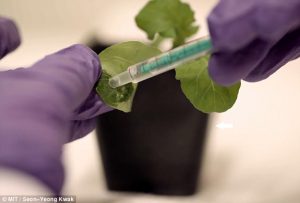Trees decorated with shining light bulbs is one of most cheerful sights during a festive night. Whether it is Christmas, New Year or Vesak we all love to have night walks under the decorated tree lights. But imagine… decorating trees with electric lights are no more needed. Trees can shine by themselves!!!! Plants in your garden start to glow, radiating dim light during night. Bigger trees beside the streets shine, illuminating the surrounding as street lamps. Small potted plants and twigs lighting up your house as firefly lights. All of these may sound pretty much like a scene from a fairy tale. Scientists from the Massachusetts Institute of Technology (MIT) are promising to turn these fairy nights in to reality in near future. But how? The answer lies in their latest finding; bio-luminescent plants.
What are bio-luminescent plants?
Bio-luminescent plants are created by incorporating nanoparticles in to watercress plants which will induce the plants to produce dim lights. The low light emitted by the plant is one thousandth (1/1000) of the amount of light required to read a book and can last for about 3.5 hours. Scientists believe that further optimization of this technique can produce enough light to illuminate a workplace, street or low intensity indoor lighting in the future.
According to the author of this study Michael Strano, professor of chemical engineering at MIT; the objective of the study was to create a desk lamp out of plants that need not to be plugged in. The method developed by the MIT research team can be used on any plant. In addition to watercress plants, arugula, kale and spinach were used for demonstrations as bio-luminescent plants.
The mechanism behind glowing.
Fireflies emit light via a chemical reaction where Luciferin is converted in to oxyluciferin in the presence of luciferase enzyme. A part of the energy released during this reaction is utilized to produce light. The same principle is applied in the bio-luminescent plants as well.

Scientists pack Luciferace, Luciferin and another molecule called as Co-enzyme A in to different types of silica nanoparticle carriers. (Coenzyme A is a molecule that helps to remove reaction byproduct in luciferin conversion that would inhibit the luciferin activity) The nanoparticle carriers deliver the components in to the correct sites of the plant while avoiding them getting concentrated on the same spot that may become toxic to the plant. The reaction taking place inside the plants makes them ‘bio-luminescence’. MIT scientists also demonstrate a way that can turn off these glowing trees by adding nanoparticles carrying luciferace inhibitor. So ideally the trees can function as light bulbs by producing light when needed and turning off in response to environmental conditions like sunlight.
Will the glowing plants light our future?
By optimizing the chemical concentrations and the release rates of the components, the light emitted and its duration can be enhanced further. So scientists believe that bio-luminescence plants will create a significant impact in the field of energy. Lighting account for about 20 percent of worldwide energy consumption. Replacing this energy with natural bio-luminescence can cut off considerable amount of carbon emissions.
In the future approach of this technology professor Strano’s team expect that next generation streetlights will be nothing but treated trees on the road. They hope to develop a way to paint or spray nanoparticles on to plants leaves which will enable to turn large trees in to illuminating light sources. So the days that we walk and dance under the light of tree lamps are not so far.
Reference
https://www.dailymail.co.uk/sciencetech/article-5178531/MIT-creates-bioluminescent-trees-glow-like-fireflies.html
http://news.mit.edu/2017/engineers-create-nanobionic-plants-that-glow-1213

